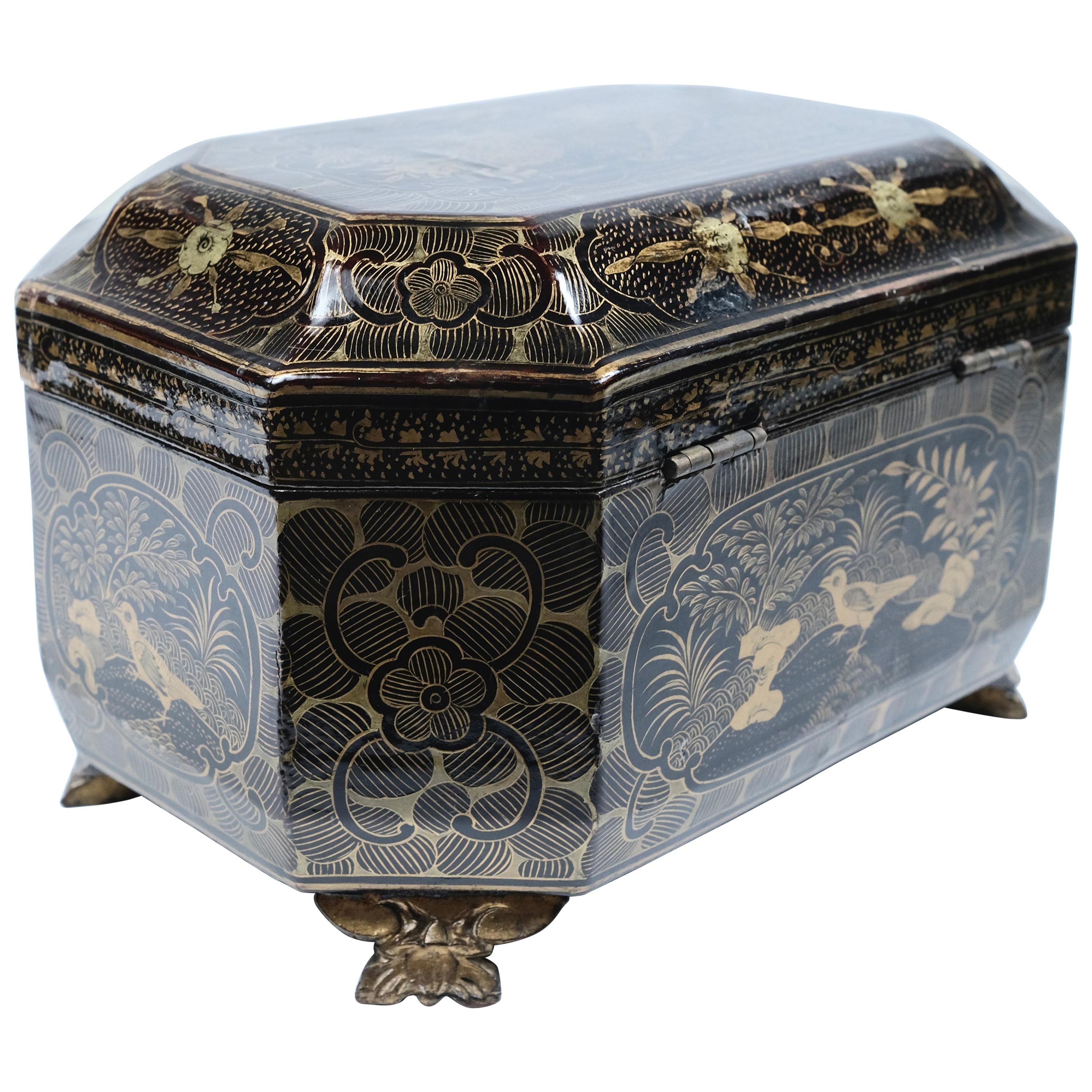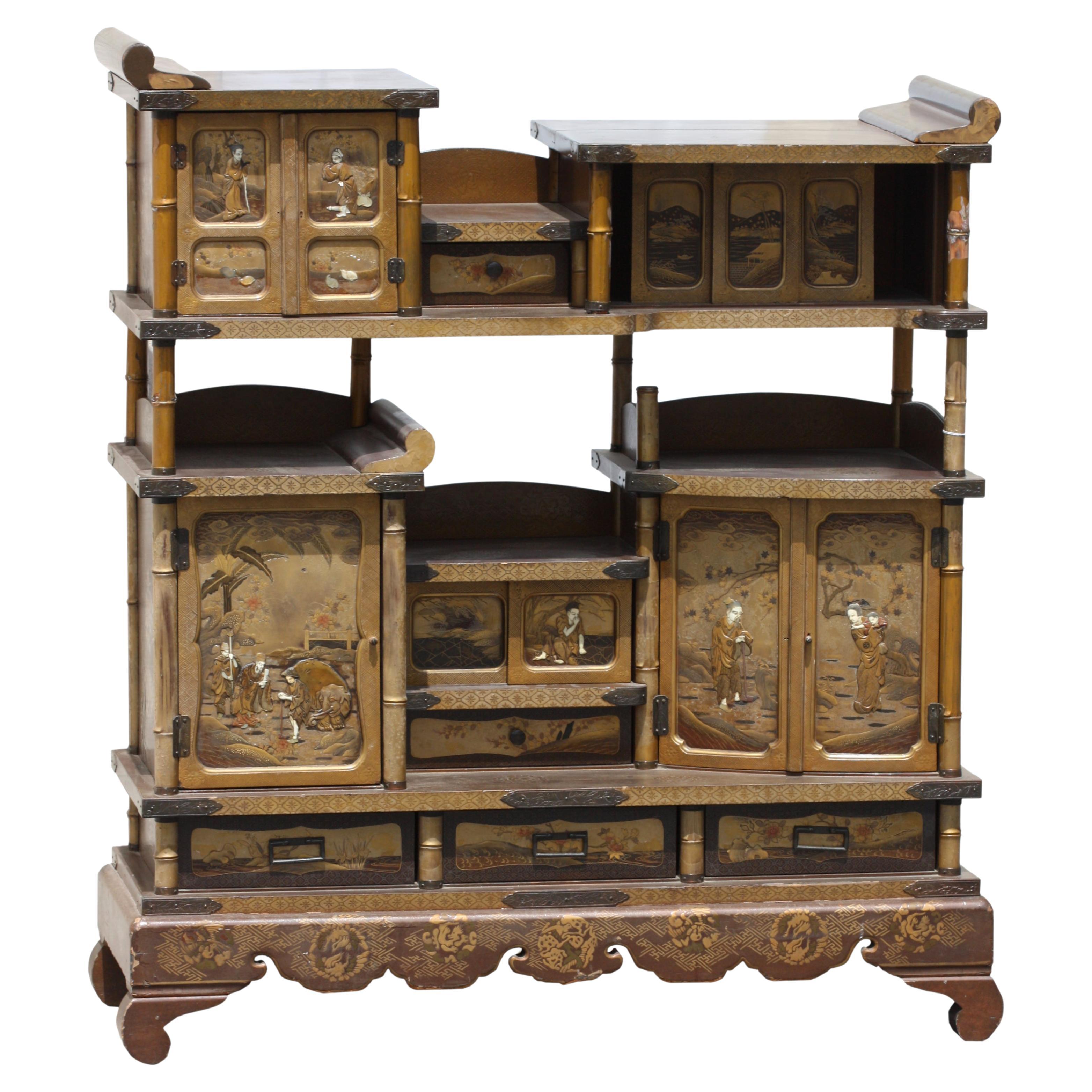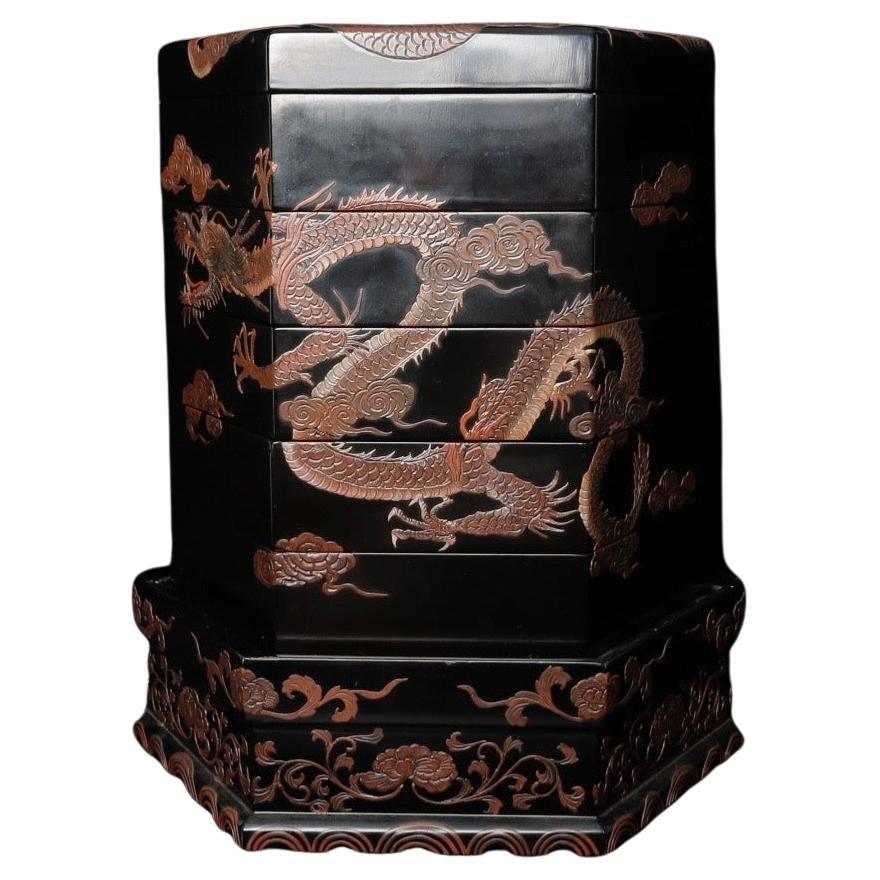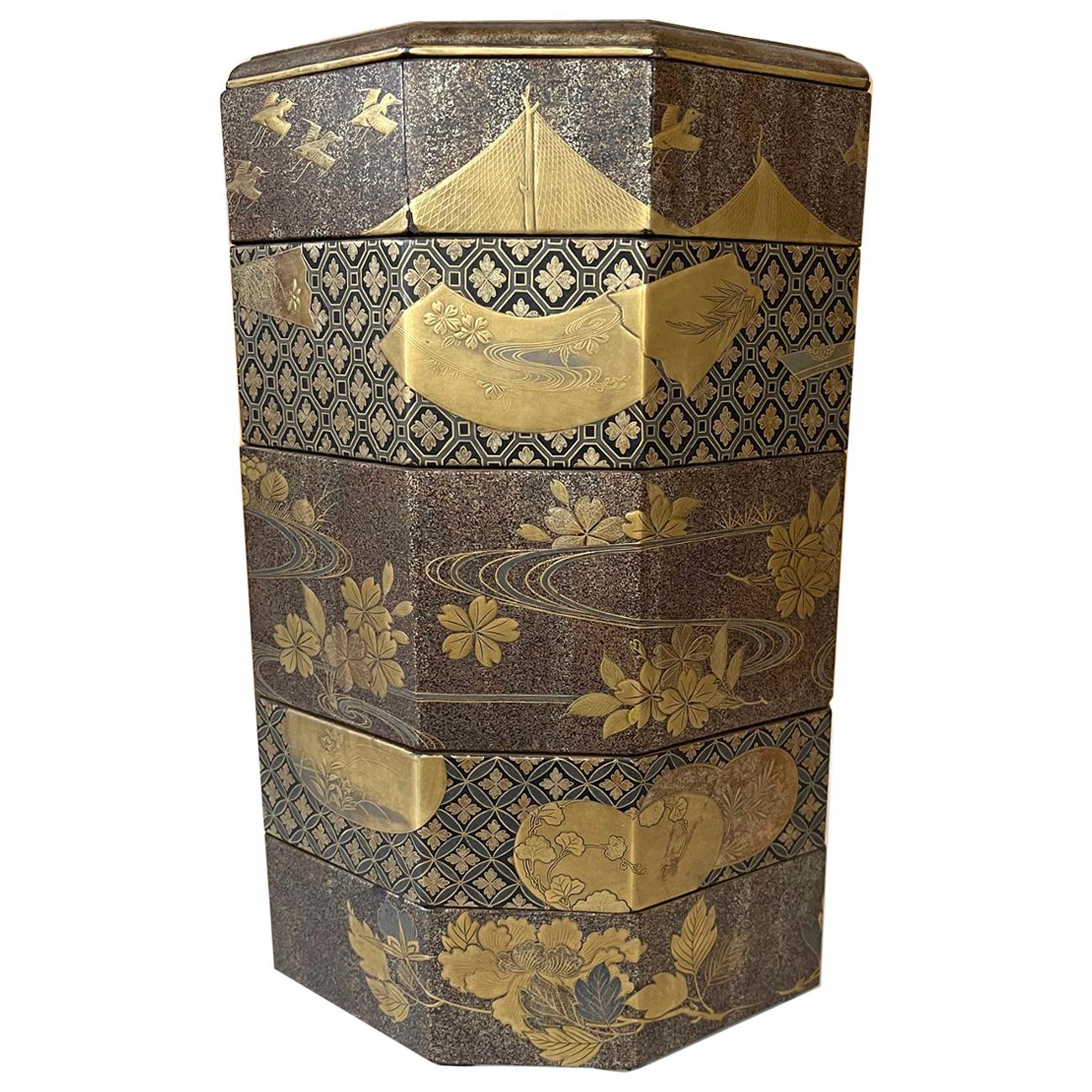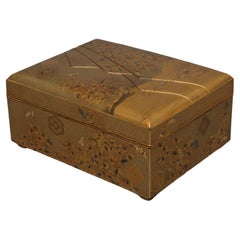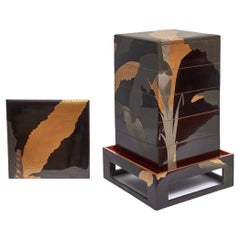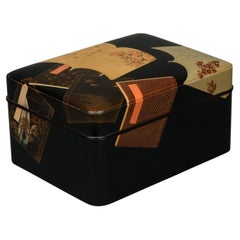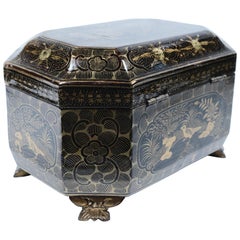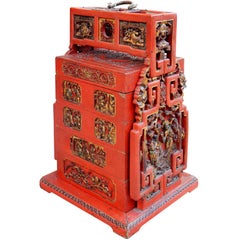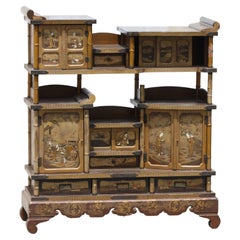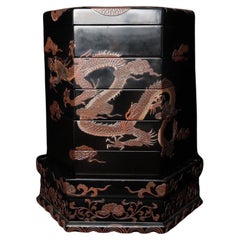Items Similar to Portable jû'bako 重箱 (tiered food container)
Want more images or videos?
Request additional images or videos from the seller
1 of 21
Portable jû'bako 重箱 (tiered food container)
$6,023.38
£4,534.69
€5,100
CA$8,297.61
A$9,292.80
CHF 4,848.83
MX$113,507.56
NOK 61,691.24
SEK 58,151.38
DKK 38,821.89
About the Item
A rare, high quality lacquered portable jû'bako (tiered food container/stacked picnic box) fitted with a removable vertical safety bar - housing a nice secret – decorated with a refined continuous design, chamfered edges, and raised by four low scalloped feet.
Executed in excellent hira’maki-e (low-relief lacquer design), taka’maki-e (high-relief lacquer design) and togidashi’makie (burnished lacquer design) in different shades of brown, gold and silver with hints of red, set on a shiny black lacquer substrate.
Adorned by a massive ancient pine tree (matsu) with a broad trunk and long curving branches. The tree is enveloped by the tendrils of a wisteria (fuji). Hence from the needle filled branches also hang beautiful strands of flowers. The roots surrounded by a few shoots of bamboo (take). It stands on a hillside next to a meandering river.
The hills and tree are done in unusually thick lacquerware, which speaks of the quality.
The decoration on the bar in front of the three drawers is designed so that the scene continues on it. When this bar is popped out, it is noticeable that it contains a secret compartment. Stored in it are a pair of chopsticks. Made from solid wood and decorated en-suite with scrolling wisteria vines in gold maki-e.
The drawers and top fitted with brass lobed bail handles on a reticulated back-plate shaped like a pile of pine tree needles.
The sides of the drawers with a matching design of scrolling wisteria vines in gold hira’maki-e. The interior and bottom side with dense reddish golden nashiji (sprinkled gold lacquer) finished by a golden fundame (matte lacquer) rims.
Including wooden tomobako (storage box).
When shipped we will add a certificate of authenticity.
Price including insured shipping.
- Dimensions:Height: 11.58 in (29.4 cm)Width: 8.39 in (21.3 cm)Depth: 8.39 in (21.3 cm)
- Materials and Techniques:
- Place of Origin:
- Period:
- Date of Manufacture:Early Meiji period (Second half 19th century).
- Condition:Repaired: The lower part of the safety bar with a restored crack as it has probably been removed forcibly in the past. Please look at the photos for a clear condition reference. Wear consistent with age and use. Minor losses. Considering its age and quality in a very good original condition with some traces of use and wear conform age, like superficial scratches and some lacquer loss along lower rims. The lower edge in front with 2.5 cm lacquer chip.
- Seller Location:Amsterdam, NL
- Reference Number:Seller: B44541stDibs: LU7165244535322
About the Seller
4.8
Vetted Professional Seller
Every seller passes strict standards for authenticity and reliability
Established in 1996
1stDibs seller since 2022
22 sales on 1stDibs
Typical response time: 22 hours
- ShippingRetrieving quote...Shipping from: Zwanenburg, Netherlands
- Return Policy
Authenticity Guarantee
In the unlikely event there’s an issue with an item’s authenticity, contact us within 1 year for a full refund. DetailsMoney-Back Guarantee
If your item is not as described, is damaged in transit, or does not arrive, contact us within 7 days for a full refund. Details24-Hour Cancellation
You have a 24-hour grace period in which to reconsider your purchase, with no questions asked.Vetted Professional Sellers
Our world-class sellers must adhere to strict standards for service and quality, maintaining the integrity of our listings.Price-Match Guarantee
If you find that a seller listed the same item for a lower price elsewhere, we’ll match it.Trusted Global Delivery
Our best-in-class carrier network provides specialized shipping options worldwide, including custom delivery.More From This Seller
View AllJapanese Ecru Lacquered Natsume 棗 'Tea Caddy' with Maki-E of Carriage Wheels
Located in Amsterdam, NL
Uncommon ecru lacquer tea caddy (natsume) with a nice golden hiramaki-e (low-relief design) of cart wheels submerged in a wild swirling stream.
The design ...
Category
20th Century Japanese Lacquer
Materials
Giltwood, Lacquer
Exceptional Japanese Gold Lacquer Tebako 手箱 'Box for Personal Accessories'
Located in Amsterdam, NL
Exceptional Japanese rectangular gold lacquer tebako (box for personal accessories) with a slightly domed well-fitted lid and raised by four low bracket feet. The lid finely carved with pointed shapes as if it is covered by folded papers.
On top of this embossed surface it is decorated with gold and silver hiramaki-e (low-relief design) and takamaki-e (high-relief design) depicting a wild winding river landscape with along the waterfront...
Category
Antique 19th Century Japanese Lacquer
Materials
Giltwood, Lacquer
Japanese lacquered 5-tiered jûbako 重箱 (picnic box) with banana leaf design
Located in Amsterdam, NL
Elegant lacquered tiered jûbako (picnic box) comprising five stackable tiers, two covers, and a raised tray. Each bearing an attractive deep chestnut brown ground and lacquered in ta...
Category
Early 20th Century Japanese Lacquer
Materials
Giltwood, Lacquer
Japanese lacquer tebako 手箱 (box for personal accessories) with book design
Located in Amsterdam, NL
Superb rectangular black lacquer tebako (box for personal accessories) with a slightly domed well-fitted lid.
The lid has a continuous soft-tone multicoloured hiramaki-e (low-relief...
Category
Early 20th Century Japanese Lacquer
Materials
Lacquer
Japanese Sado ishô dansu 衣装箪笥 (cabinet of drawers) with elaborate hardware
Located in Amsterdam, NL
Exceptional, rare and completely restored wooden Sado ishô dansu (cabinet of drawers) with elaborately decorated open work iron hardware, in two sections. Fully restored, cleaned and waxed.
The exterior is made of hinoki cypress wood. Only slightly varnished, giving it a tad warmer colour. This soft underground lets the refined hardware stand out even more.
The upper part consists of two large drawers. The lower part with two drawers of different size and a hinged door. The interior behind the door with three small drawers. All the drawers are very deep and have a lot of volume, for easy storage. They run very smoothly as well.
The cabinet has extensively decorated hardware. The corner pieces of the drawers with stylized pine trees. The large decorative lock plates each with their own unique design of different auspicious animals; a peacock, a phoenix, a crane and a minogame. The hinged door decorated with different attributes of the Seven Gods of Fortune...
Category
Antique Late 19th Century Japanese Furniture
Materials
Iron
Japanese round wooden cha'dansu 茶箪笥 (tea cabinet)
Located in Amsterdam, NL
A remarkable round cha'dansu (tea cabinet) crafted from a hollowed tree trunk, resting on an organically shaped three-root base.
The exterior showcases a striking natural texture, e...
Category
Early 20th Century Japanese Furniture
Materials
Wood
You May Also Like
19th Century Chinese Tea Caddy
Located in Los Angeles, CA
Hand painted with chinoiserie motif. Original inserts with etching.
Category
Antique 19th Century Chinese Tea Caddies
Materials
Zinc
Fine Chinese Lacquered Food Storage Box of Impressive Size
Located in Hudson, NY
This large and impressive Mandarin food storage box is very detailed and well-constructed. The case, made of finely carved wood, houses five different stackable storage boxes. Each b...
Category
Antique 19th Century Chinese Furniture
Materials
Bronze
Japanese Export Lacquer Cabinet
Located in West Palm Beach, FL
A Japanese export lacquer cabinet, After Nagasaki late 19th century
decorated throughout with foliate, bird and geometric motifs and painted mother of...
Category
Antique 19th Century Antiquities
Materials
Wood
19th century Dragon lacquer box
Located in Fukuoka, JP
Large Lacquered hexagonal box on stand depicting Dragon flying amidst the clouds. Unique , appliqués like lacquer technique created amazing effect of almost 3d effect. Multilayered ...
Category
Antique 19th Century Japanese Edo Lacquer
Materials
Wood, Lacquer
Japanese Lacquer Smoking Box, Tabako Bon, Edo Period, 19th Century
Located in Austin, TX
A very fine Japanese maki-e lacquer decorated tabako bon, or smoking box, late Edo Period, mid-19th century, Japan.
The elegant smoking box of black lacquer decorated with a wonderful gold lacquer takamaki-e design of a gnarled and elegantly twisted plum tree with branches in full bloom. A border of golden cranes in flight to the top.
The smoking box, called a tabako bon, is comprised of an open section at the top with inset with two cylindrical metal canisters...
Category
Antique Mid-19th Century Japanese Edo Lacquer
Materials
Lacquer
Japanese Maki-e Lacquer Stack Box Jubako
Located in Atlanta, GA
An antique jubako (stack boxes) with five tiers in an elongated octagon shape circa 19th century (end of Edo or beginning of Meiji period). jubako was traditionally used to store and...
Category
Antique 19th Century Japanese Japonisme Lacquer
Materials
Wood, Lacquer
More Ways To Browse
Black And Red Lacquer
Black Lacquer Storage
Black Lacquer Bars
Wood Container
Antique Container
Antique Containers
Antique Furniture Containers
Brass Container
Ancient Scrolls
Japanese Containers
Container Ship
Antique Shooting
Secret Compartment Furniture
Bamboo Black Lacquered
Red Lacquer Bar
Asian Containers
Antique Furniture Strand
Antique Furniture With Secret Compartments
